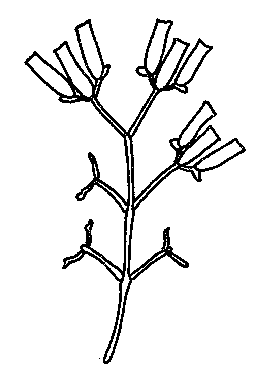
Distribution Map

Description (Barlow 1993)
Decaisnina pedicellata (Danser) Barlow
Amylotheca triflora var. pedicellata Danser, Blumea 3 (1938) 39. -Decaisnina pedicellata (Danser) Barlow, Austral. J. Bot. 22 (1974) 541. - Type: Carr 12077 (holo L 936,105-256; iso CANB 59579), Papua, Koitaki, c. 1500 ft (450 m), 28.iv.1935.
For description see Barlow, Austral. J. Bot. 22 (1974) 541. Decaisnina pedicellata has few specialized characters, and thus presents a relatively generalized facies for the genus. The species can be identified locally by its combination of terete stems, shortly and obscurely petiolate, somewhat falcate, isofacial, dull leaves with many distinct lateral veins close together, slender inflorescences with few pairs of triads and the lateral flowers of the triads pedicellate, and the anthers about one third as long as the free parts of the filaments. The flower colour has been recorded as pale pink or purplish, sometimes deeper crimson in the lower part.
Decaisnina pedicellata has a small area on the Sogeri Plateau in New Guinea (Fig. 8; 5 collections seen), recorded at elevations from 425 to 600 m. Habitat details are poorly known; the only recorded host is Engelhardtia.
The species is probably related to the more widespread D. triflora from which it differs in its leaf characters mentioned above, its slender shorter inflorescences, and the relatively longer free parts of the anther filaments. It is also similar to D. congesta of New Guinea and north Queensland, which may have a similar phyletic relationship with D. triflora. It shows a general resemblance to D. congesta in habit, but differs in its leaf and stamen characters, its inflorescence of more uniformly spaced triads, the pedicellate lateral flowers, and the flower colour. Both of these species may be young differentiates of D. triflora and are located just beyond the geographic limits of this more widespread and variable entity. See note under D. triflora.
Description (Barlow 1974)
Decaisnina pedicellata (Dans.) Barlow, comb. et stat. nov.
Amylotheca triflora var. pedicellata Dans. Blumea 3: 39 (1938). Type.-Koitaki, 430 m alt., Carr 12077, 28.iv.1935 (L 936105256, holotype; CANB 59579).
Glabrous. Young and old stems terete, slightly enlarged at the nodes. Petiole obscure, 3-5 mm long; lamina broad lanceolate to elliptical, more or less falcate, 7-10 by (1. 5)-2-3.5 cm, dull on both sides, attentuate at the base, slightly acuminate but finally obtuse or rounded at the apex; venation pennate, distinct with many lateral veins visible on both sides. Inflorescences solitary in the axils; axis slender, bearing c. 4 pairs of crowded triads, c. 1 cm long; peduncles of the triads slender, c. 2 mm long; pedicels of the lateral flowers of the triads c. 1 mm long; bracts spreading, acute or truncate, sometimes weakly toothed, 1 mm long. Calyx narrow cylindrical, 2.5 mm long; limb entire, undulate, spreading, 0.5 mm long. Corolla in the mature bud very slender, 0.5 mm long; petals in the open flower coherent in the lower 2-3 mm. Anthers c. 1.5 mm long; free parts of the filaments c. 5 mm long. Style articulate c. 1 mm above the base. (Fig. 1, a.)
Occurrence. Papua, recorded only from the Sogeri Plateau (Fig. 2), 400 to 600 m altitude.
Specimens Examined. EASTERN NEW GUINEA: Laloki R., Rouna, 450 m alt., Brass 3622, 11.iii.1933 (L); Rouna, 400 m alt., Carr 12836, 12.vii.1935 (CANB; L); Sirinumu, c. 600 m alt., Barlow 978, 20.ii.1965 (AD; LAE).
These specimens, although they may all
represent the same local population, are sufficiently distinct
from the materials examined of other species to be accorded specific
status. Decaisnina pedicellata may be distinguished from
its congeners by its somewhat falcate leaves with many distinct
lateral veins, the short crowded inflorescence and the
pedicellate lateral flowers of the triads.
Illustrations

Decaisnina pedicellata. Infructescence. From Barlow (1974).
Photographs
Decaisnina pedicellata
updated 19 January 2007